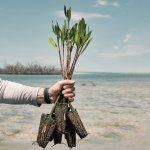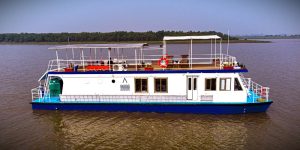Coasts under pressure; working with nature to protect.
On the evening of January 31, 1953, an unexpected and devastating storm surge hit the coastlines of the North Sea. It marked one of the deadliest natural disasters of the 20th century. Particularly in the Netherlands, the catastrophe wasn’t just about the staggering loss of 1,836 lives and the obliteration of tens of thousands of homes — it was a wake-up call. This event, seared into Dutch history as ‘Watersnoodramp‘, would reshape the nation’s relationship with its coastline for decades to come. Motivated by this tragic event, the Netherlands embarked on an unprecedented mission, building formidable barriers to fend off nature’s wrath.
For the next 50 years, they started erecting barriers that would protect them from such storms. Dike after dike, barrier after barrier, the country solidified its grip on the coastline — and even claimed more land. The coastal defenses promised to shield the nation from even the most powerful storms. No disaster like the dreaded Watersnoodramp would ever happen again. It worked. The Delta Works, as the project was named, quickly became the poster child of hard concrete coastal defense.
But all was not well. Environmental scientists have long highlighted the many flaws of this hard engineering approach and the long-term problems it can cause. Hard concrete barriers increase erosion in some areas and cause excessive sedimentation in others; they destroy habitats and disrupt tidal dynamics, affecting the entire coast; they affect the quality of sandbanks, vegetation, and dunes in the area. And that’s just to name a few of the problems. To make matters even worse, there’s also climate change. Sea levels are rising and storm surges are becoming more common across the world, as are all sorts of extreme weather events. This risks overcoming the hard, immobile engineered barriers.
This issue isn’t unique to the Netherlands. About 40% of the world’s population lives within 100 kilometers of the coast. It’s never been more important to safeguard our shorelines. We could just keep building bigger dikes and barriers. But there’s an increasing realization that brute force may not be the answer. Instead, scientists and local communities are now looking towards nature instead. Nature-inspired coastal management is gaining traction due to its sustainable, long-term benefits for both communities and ecosystems.
Real-world examples, like the Langwarder Groden in Lower Saxony, Germany, showcase its potential. Leena Karrasch, a coastal protection expert at the University of Oldenburg with over a decade of experience, explains: “In places like the Netherlands and northern Germany, we use a distinct dike system to shield against storm surges. This comprises a primary, inner dike, and a secondary, ‘summer dike. The innovation at Langwarder Groden is the deliberate opening of the outer dike, permitting saltwater to naturally ebb and flow between the two barriers. By doing this, we cultivate salt marsh habitats, which not only boosts biodiversity but also strengthens natural defenses against surges,” says Karrasch.
The story of Langwarder Groden serves as an inspiration that highlights the power of nature-based solutions — a huge field that goes far beyond salt marshes and flood barriers. Coastal ecosystems are among the most vulnerable in the world, facing constant threats, many stemming from human activity. As communities grapple with escalating climate change and extreme weather, turning to nature-based solutions could be a lifeline. The concept of collaborating with nature to manage coastlines isnt novel. Historically, humans have relied on nature for coastal protection for centuries.
Source: zmescience.com





